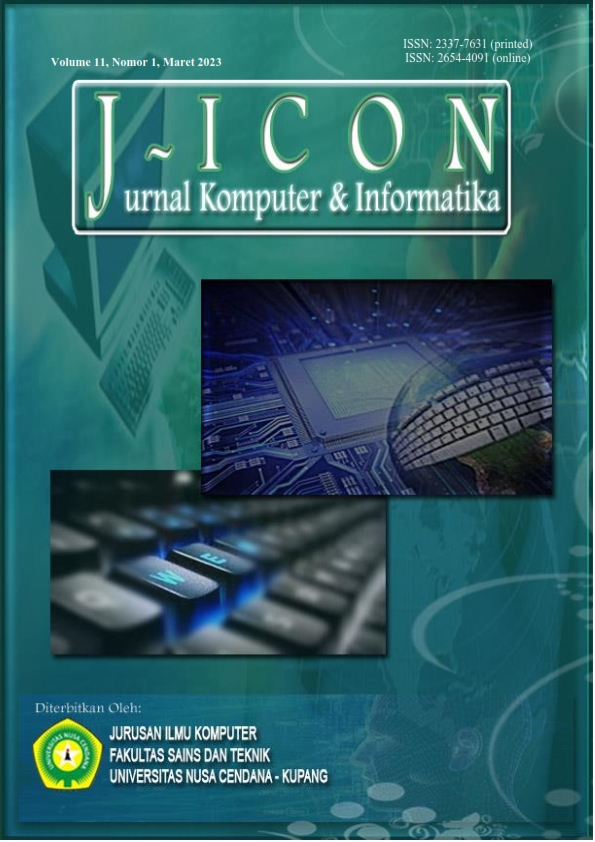EXPERT SYSTEM-BASED GASTROENTERITIS DIAGNOSIS USING THE FUZZY METHOD AND CERTAINTY FACTOR
Abstract
Gastroenteritis is inflammation of the stomach and intestines with symptoms of diarrhea and often fever. The disease in question is repeated defecation, more than four times, and the type of liquid stool, which can be accompanied by blood or mucus. Digestive disorders this disease occurs due to viruses, bacteria, or parasites. This disease is often underestimated because the symptoms are almost the same as diarrhea, so if it is not handled properly, it can endanger the patient's life, especially with conditions that are getting weaker and worse. This study aims to create an expert system application program that can diagnose Gastroenteritis, the results of which can show the disease suffered by the patient. 16 symptom data will be used, namely Fever above 38C, Chills, Headache, Nausea, Lack of appetite, Easy Drowsiness, Constant thirst, Watery stools, Discomfort, Stomach cramps/bloating, Dehydration, Weight loss, Diarrhea with blood, restlessness, weakness, no urine in the diaper for 3 hours or more. To demonstrate its confidence percentage, the authors chose the Fuzzy Logic and Certainty Factor methods as the basis for calculating the archival samples from the clinic with 100% confidence percentage. Based on the expert system trials and the resulting Certainty Factor values, it can be concluded that the expert system that has been created makes it easier to determine Gastroenteritis so that it can be handled properly and correctly.
Downloads
References
Soewito, “Kebiasaan Berperilaku Hidup Sehat Dan Nilai-Nilai Pendidikan Karakter,” Kinabalu, vol. 11, no. 2, pp. 50–57, 2013, doi: 10.21831/jpk.v0i2.1303.
V. N. Sari, “Asuhan Keperawatan Pada Klien TN. S Dengan Kasus Gastroenteritis Akut Diruang Melati Rsd Balung Jember,” Univ. Muhammadiyah Jember, 2021.
Khoiriyah, H. Widjajanegara, and F. Sjafei, “Scoping Review: Efektivitas Pemberian Sinbiotik pada Pasien Anak Gastroenteritis Akut,” Pros. Kedokt., vol. 7, no. 1, pp. 783–794, 2021. Available: http://repository.unisba.ac.id/handle/123456789/29861.[Accessed: Mar. 27, 2023].
M. Silmi, E. A. Sarwoko, and F. Chaining, “Sistem Pakar Berbasis Web Dan Mobile Web Untuk Mendiagnosis Penyakit Darah Pada Manusia Dengan Menggunakan Metode Inferensi Forward Chaining” Masy. Inform., vol. 4, pp. 31–38, 2018, doi: 10.14710/jmasif.4.7.8459.
A. K. Nisa, M. Abdy, and A. Zaki, “Penerapan Fuzzy Logic untuk Menentukan Minuman Susu Kemasan Terbaik dalam Pengoptimalan Gizi,” J. Math. Comput. Stat., vol. 3, no. 1, p. 51, 2020, doi: 10.35580/jmathcos.v3i1.19902.
D. Deslianti, U. M. Bengkulu, U. M. Bengkulu, and C. Factor, “Penerapan Metode Certainty Factor Dalam Pendahuluan Studi Literatur,” vol. 3, pp. 456–465, 2020, doi: 10.54650/jukomika.v3i4.311.
M. D. Irawan and H. Herviana, “Implementasi Logika Fuzzy Dalam Menentukan Jurusan Bagi Siswa Baru Sekolah Menengah Kejuruan (SMK) Negeri 1 Air Putih,” J. Teknol. Inf., vol. 2, no. 2, p. 129, 2019, doi: 10.36294/jurti.v2i2.427.
R. Rachman and A. Mukminin, “Penerapan Metode Certainty Factor Pada Sistem Pakar Penentuan Minat dan Bakat Siswa SD,” Khazanah Inform. J. Ilmu Komput. dan Inform., vol. 4, no. 2, pp. 90–97, 2018, doi: 10.23917/khif.v4i2.6828.
N. Ahmad and Iskandar, “Metode Forward Chaining untuk Deteksi Penyakit Pada Tanaman Kentang,” JINTECH J. Inf. Technol., vol. 1, no. 2, pp. 7–20, 2020, doi: 10.22373/jintech.v1i2.592.
N. M. D. Febriyanti, A. A. K. O. Sudana, and I. N. Piarsa, “Implementasi Black Box Testing pada Sistem Informasi Manajemen Dosen,” J. Ilm. Teknol. dan Komput., vol. 2, no. 3, pp. 1–10, 2021. Available: https://ojs.unud.ac.id/index.php/jitter/article/view/79610. [Accessed: Mar. 27, 2023].
Andria, “Perancangan Basis Data Sistem Pembayaran Sport Center Berbasis Mysql,” J. Ilm. DASI, vol. 16, no. 1, p. 55, 2015. Available: https://ojs.amikom.ac.id/index.php/dasi/article/view/1096. [Accessed: Mar, 27, 2023]
Copyright (c) 2023 Sabilatul Hidayah, Yoannes Romando Sipayung

This work is licensed under a Creative Commons Attribution 4.0 International License.
The author submitting the manuscript must understand and agree that if accepted for publication, authors retain copyright and grant the journal right of first publication with the work simultaneously licensed under a Creative Commons Attribution (CC-BY) 4.0 License that allows others to share the work with an acknowledgment of the work’s authorship and initial publication in this journal.
 Sabilatul Hidayah(1)
Sabilatul Hidayah(1)




